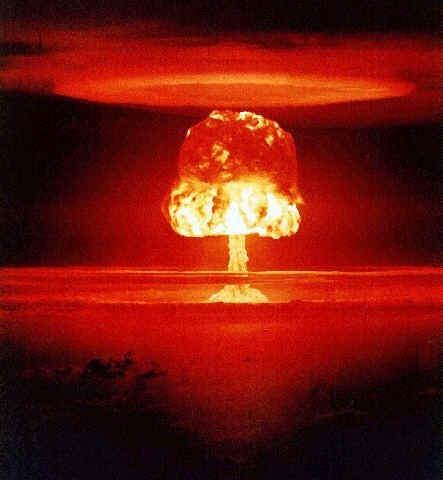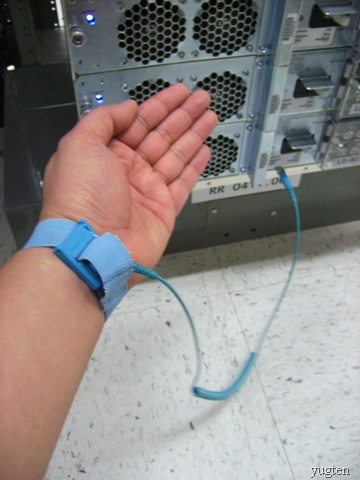Physicist: The weapon itself doesn’t cause the EMP (or not much of one). The pulse is actually generated by the weapon’s effect on the Earth’s ionosphere.

Nukes: bad piece of business. The explosion itself expands in every direction, but the pillar of fire and the mushroom cloud are direct results of the convection currents (updraft) caused by the heat.
An EMP is just a sudden change in the electric and magnetic fields, which on its own isn’t too bad. It doesn’t hurt people at least. However, changing EM fields induce currents in anything capable of carrying a current. This is especially true of power lines, where the current can really “build up some steam”. The problem with current suddenly showing up where it’s not expected is that it can arc or overload circuits. The kind of components and wiring you find in today’s electronics (and the last 30 some odd years) can be destroyed by the sort of sudden surge you get from regular old static electricity.
Of course because of that, sensitive electronics are generally grounded (with ground lines!) and/or shielded with Faraday cages.
The way you generate an EMP (or any interesting electromagnetic effect) is you get a bunch of charge and suddenly move it. A nuclear weapon on its own doesn’t have a bunch of extra charges to move around, but luckily (unluckily?) the Earth abides! Between about 40 and 300 miles above your head (about 39 and 299 miles for our Denver readers) there’s a layer of charged particles called the ionosphere. It’s created by radiation from space (mostly the Sun) knocking electrons free of their host atoms. A nuke releases enough heat, suddenly enough, that the resulting upward and outward “puff” of air literally moves the ionosphere overhead. That moving charge is what causes the bulk of the EMP. To a lesser extent, a nuclear device also ionizes the surrounding air, and then moves that.
The Soviets and Americans, being good at this sort of thing, have done a number of tests that involved setting off nuclear devices in and just above the ionosphere. The best known are America’s “Starfish Prime” (you’d think the black ops people would hire better namers-of-things) and the USSR’s “test 184” (classy name).
According to a review for the US Energy Research and Development Administration, EMP damage was recorded almost a thousand miles away:
“Starfish produced the largest fields of the high-altitude detonations; they caused outages of the series-connected street-lighting systems of Oahu (Hawaii), probable failure of a microwave repeating station on Kauai, failure of the input stages of ionospheric sounders and damage to rectifiers in communication receivers. Other than the failure of the microwave link, no problem was noted in the telephone system.”
The Soviet tests sound even more fun, but the relevant details are a little harder to track down:
“…it knocked out a major 1000-kilometer (600-mile) underground power line running from Astana to the city of Almaty. Several fires were reported. In the city of Karagandy, the EMP started a fire in the city’s electrical power plant, which was connected to the long underground power line.” (ref.)
It’s worth mentioning that nuclear bombs aren’t the only thing that cause these sorts of large-scale electronic nastiness. Any bomb big enough will have a similar effect (if there were other bombs big enough). Also, every now and again, the Sun belches out a cloud of ionized gas that pushes the Earth’s magnetic field around. The results are the similar to a nuclear EMP, but global and toned way down. These “geomagnetic storms” mostly just mess with communication channels, which are often already bumping up against their signal-to-noise limit.








So if you blew up a nuclear weapon in space or on a body without atmosphere (like say the moon) you wouldn’t get an EMP?
Nope!
Do underground detonations have the same effect as above ground detonations?
No, the EMP of an underground explosion is very small.
But oddly enough, the effect may not be zero!
If a nuclear device were to go off at a distance not lethal to the average person in their home, but still within EMP affection range, what would happen to the average electronic device? You mentioned that many items are now earthed or equipped with Faraday cages, but I doubt that it is the majority. Let’s say, a cellphone, computer, microwave for starters. Thanks for the deeply interesting article!
A “Faraday cage” is basically just a metal box, preferably grounded. So most computers are at least a little shielded.
The short answer is: they’d probably just break and need to be replaced. One or two electrical arcs in a CPU is more than enough to total a computer or cell phone.
The long answer is: I don’t know. The strength of an EMP is dependent on all kinds of stuff, including the location and yield of the weapon, the local ionization (which involves the time of day), the local strength of the magnetic field, … Even worse, putting nuclear stuff in space was outlawed in 1963, back before there was anything interesting worth breaking. I’m not sure if anyone has bothered doing small-scale lab tests.
Nice article! You talk about EMPs generated after a nuclear blast, but how is it that an EMP bomb manages to disrupt the ionosphere? I mean like the the one in Ocean’s Eleven, or 24’s season 4, which left an entire city out of power. (Do they exist?)
If they exist, they’re being kept secret. But they’d work on the same idea: move a bunch of charge fast.
Wikipedia seems to suggest that you can create an EMP by shooting gamma radiation at the upper atmosphere, detaching electrons from the atoms up there which promptly move downward at relativistic speeds thanks to the earth’s magnetic field. Presumably if you could make some kind of gamma burst in the upper atmosphere without using a nuclear warhead you’d get some kind of EMP out of it.
What is the effect on photovoltaic arrays (solar Panels)?
Assuming non-grounded operation, or single point only grounding, would there just be an increase in output for that instant? … owr would there be a catastrophic avalanche?
By and large, photovoltaics are very picky about what kind of light they’ll absorb. Gamma rays are unlikely to generate any power. However, the EMP itself may generate some power in the cables leading to and from the panels.
I understand that energy cannot be created nor destroyed, so what happens to the energy that is hit by the EMP? Does it stop, or get moved somewhere else? What happens to it?
Also, thank you for the article.
It mostly turns into heat.
First of, I want to thank you for this article. Nice to visit some corners of the internet where facts matter.
I do have a question: Could the friction generated by a big meteor in the ionosphere created an EMP? We’ll assume an object that wouldn’t crash on Earth.
It is my understanding that any electrical discharge powerful enough to create a plasma creates an EMP? Such as experimental rail guns and flash power discharges, even lightning. If this is accurate is it not probabable that rapid discharge capacitors with very large voltage and amperage levels hooked to discharge simultaneously through a conductor which degraded (upgraded) to plasma could create a very large but more localized EMP?
Regarding the EMP being generated by a sudden upward movement of an ionized body of air (ionosphere). I assume that the ionosphere has “bulk charge neutrality”, and that the vertical component of charge motion is equal for the negatively-charged free electrons and the positively-charged ionized atoms, thus cancelling out any net vertical charge motion. Is it then the horizontal component of charge motion caused by the earth’s magnetic field (Lorentz force) that is unbalanced between the nearly mass-less electrons and the much more massive atomic ions that results in a net charge motion?
I’ve read that a high altitude nuke detonation produces a sequence of 3 EMPs, called E1, E2, and E3. E1 occurs at the moment of detonation and is of much shorter duration than a lightning bolt, and is what causes the most damage. E2 is approximately of the same duration as a lightning bolt and causes additional damage. E3 is the least damaging, and tends to just disrupt radio communications. E3 can last for several minutes. The source of my info on this did not explain the actual science/physics reasons for the E1 and E2 pulses, but claimed that E3 is caused by a disruption to the earth’s magnetic field (the magnetosphere, not ionosphere). My source was some guy on a comments section of a news story, not a physicist, however since you are a physicist, maybe you can shed more light onto this EMP phenominon. I’m really interested in learning more about it.
So Physicist, can you please expand your article here to give a more in depth explanation of the nuclear EMP effect, including all 3 pulses (E1, E2, and E3) that are produced by a high altitude nuclear explosion? I’m particularly interested in the exact causes of each of these 3 pulses, as well as descriptions of their effects, and how one can protect against them.
I am wondering…can a dirty bomb create an emp situation
What happens to a diamond or a crystal that has been subjected to a high electrical or electrical magnetic charge? Especially if the diamond is enclosed within that charge?
Pingback: The Case Of The Explosive Nuclear Time Traveler | Mystic Investigations Paranormal Stories
Will an EMP fry solar panels? If not, would any power travel along the wires from the solar panels to the invertor/convertor equipment fry the invertor/convertor and other electronic components typically involved in a stand-alone off-grid system?
Can an EMP cause avalanches…?
Seems the Physicist has ceased answering questions on this topic.
Pingback: The Case Of The Explosive Nuclear Time Traveling Spirit | Ask Mystic Investigations